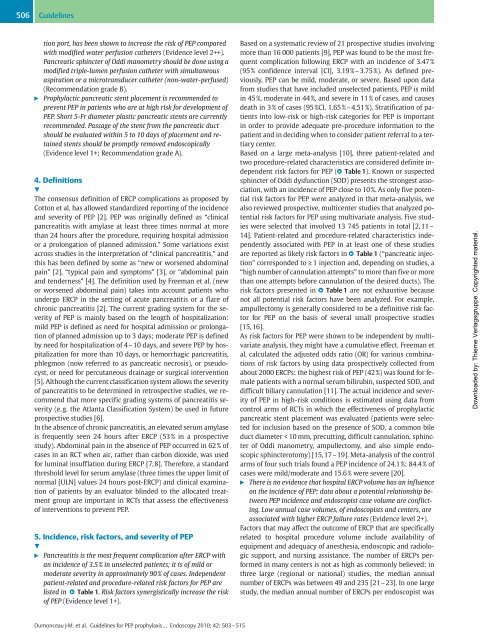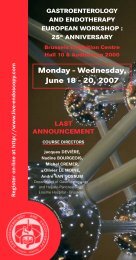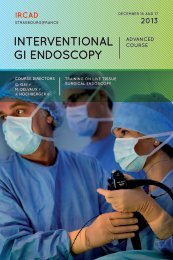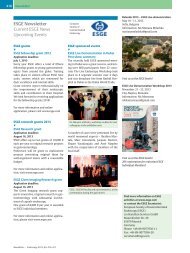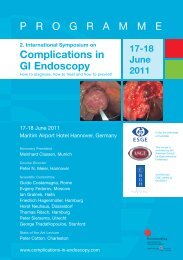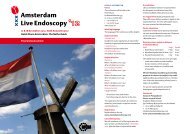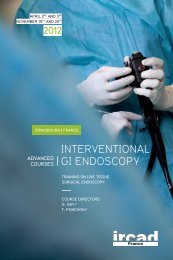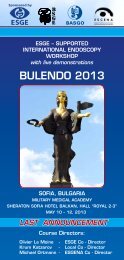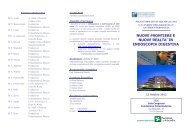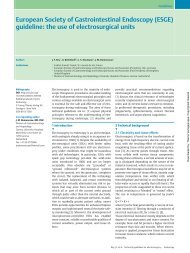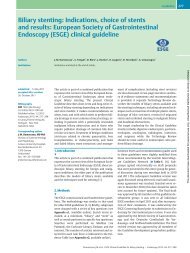(ESGE) Guideline: Prophylaxis of post-ERCP ... - ResearchGate
(ESGE) Guideline: Prophylaxis of post-ERCP ... - ResearchGate
(ESGE) Guideline: Prophylaxis of post-ERCP ... - ResearchGate
You also want an ePaper? Increase the reach of your titles
YUMPU automatically turns print PDFs into web optimized ePapers that Google loves.
506<br />
<strong>Guideline</strong>s<br />
tion port, has been shown to increase the risk <strong>of</strong> PEP compared<br />
with modified water perfusion catheters (Evidence level 2++).<br />
Pancreatic sphincter <strong>of</strong> Oddi manometry should be done using a<br />
modified triple-lumen perfusion catheter with simultaneous<br />
aspiration or a microtransducer catheter (non-water-perfused)<br />
(Recommendation grade B).<br />
" Prophylactic pancreatic stent placement is recommended to<br />
prevent PEP in patients who are at high risk for development <strong>of</strong><br />
PEP. Short 5-Fr diameter plastic pancreatic stents are currently<br />
recommended. Passage <strong>of</strong> the stent from the pancreatic duct<br />
should be evaluated within 5 to 10 days <strong>of</strong> placement and retained<br />
stents should be promptly removed endoscopically<br />
(Evidence level 1+; Recommendation grade A).<br />
4. Definitions<br />
!<br />
The consensus definition <strong>of</strong> <strong>ERCP</strong> complications as proposed by<br />
Cotton et al. has allowed standardized reporting <strong>of</strong> the incidence<br />
and severity <strong>of</strong> PEP [2]. PEP was originally defined as “clinical<br />
pancreatitis with amylase at least three times normal at more<br />
than 24 hours after the procedure, requiring hospital admission<br />
or a prolongation <strong>of</strong> planned admission.” Some variations exist<br />
across studies in the interpretation <strong>of</strong> “clinical pancreatitis,” and<br />
this has been defined by some as “new or worsened abdominal<br />
pain” [2], “typical pain and symptoms” [3], or “abdominal pain<br />
and tenderness” [4]. The definition used by Freeman et al. (new<br />
or worsened abdominal pain) takes into account patients who<br />
undergo <strong>ERCP</strong> in the setting <strong>of</strong> acute pancreatitis or a flare <strong>of</strong><br />
chronic pancreatitis [2]. The current grading system for the severity<br />
<strong>of</strong> PEP is mainly based on the length <strong>of</strong> hospitalization:<br />
mild PEP is defined as need for hospital admission or prolongation<br />
<strong>of</strong> planned admission up to 3 days; moderate PEP is defined<br />
by need for hospitalization <strong>of</strong> 4 – 10 days, and severe PEP by hospitalization<br />
for more than 10 days, or hemorrhagic pancreatitis,<br />
phlegmon (now referred to as pancreatic necrosis), or pseudocyst,<br />
or need for percutaneous drainage or surgical intervention<br />
[5]. Although the current classification system allows the severity<br />
<strong>of</strong> pancreatitis to be determined in retrospective studies, we recommend<br />
that more specific grading systems <strong>of</strong> pancreatitis severity<br />
(e.g. the Atlanta Classification System) be used in future<br />
prospective studies [6].<br />
In the absence <strong>of</strong> chronic pancreatitis, an elevated serum amylase<br />
is frequently seen 24 hours after <strong>ERCP</strong> (53 % in a prospective<br />
study). Abdominal pain in the absence <strong>of</strong> PEP occurred in 62 % <strong>of</strong><br />
cases in an RCT when air, rather than carbon dioxide, was used<br />
for luminal insufflation during <strong>ERCP</strong> [7, 8]. Therefore, a standard<br />
threshold level for serum amylase (three times the upper limit <strong>of</strong><br />
normal [ULN] values 24 hours <strong>post</strong>-<strong>ERCP</strong>) and clinical examination<br />
<strong>of</strong> patients by an evaluator blinded to the allocated treatment<br />
group are important in RCTs that assess the effectiveness<br />
<strong>of</strong> interventions to prevent PEP.<br />
5. Incidence, risk factors, and severity <strong>of</strong> PEP<br />
!<br />
" Pancreatitis is the most frequent complication after <strong>ERCP</strong> with<br />
an incidence <strong>of</strong> 3.5 % in unselected patients; it is <strong>of</strong> mild or<br />
moderate severity in approximately 90% <strong>of</strong> cases. Independent<br />
patient-related and procedure-related risk factors for PEP are<br />
listed in ● " Table 1. Risk factors synergistically increase the risk<br />
<strong>of</strong> PEP (Evidence level 1+).<br />
Dumonceau J-M. et al. <strong>Guideline</strong>s for PEP prophylaxis … Endoscopy 2010; 42: 503 –515<br />
Based on a systematic review <strong>of</strong> 21 prospective studies involving<br />
more than 16 000 patients [9], PEP was found to be the most frequent<br />
complication following <strong>ERCP</strong> with an incidence <strong>of</strong> 3.47 %<br />
(95 % confidence interval [CI], 3.19 % – 3.75 %). As defined previously,<br />
PEP can be mild, moderate, or severe. Based upon data<br />
from studies that have included unselected patients, PEP is mild<br />
in 45%, moderate in 44 %, and severe in 11% <strong>of</strong> cases, and causes<br />
death in 3% <strong>of</strong> cases (95 %CI, 1.65%–4.51 %). Stratification <strong>of</strong> patients<br />
into low-risk or high-risk categories for PEP is important<br />
in order to provide adequate pre-procedure information to the<br />
patient and in deciding when to consider patient referral to a tertiary<br />
center.<br />
Based on a large meta-analysis [10], three patient-related and<br />
two procedure-related characteristics are considered definite independent<br />
risk factors for PEP (● " Table 1). Known or suspected<br />
sphincter <strong>of</strong> Oddi dysfunction (SOD) presents the strongest association,<br />
with an incidence <strong>of</strong> PEP close to 10 %. As only five potential<br />
risk factors for PEP were analyzed in that meta-analysis, we<br />
also reviewed prospective, multicenter studies that analyzed potential<br />
risk factors for PEP using multivariate analysis. Five studies<br />
were selected that involved 13 745 patients in total [2, 11 –<br />
14]. Patient-related and procedure-related characteristics independently<br />
associated with PEP in at least one <strong>of</strong> these studies<br />
are reported as likely risk factors in● " Table 1 (“pancreatic injection”<br />
corresponded to ≥ 1 injection and, depending on studies, a<br />
“high number <strong>of</strong> cannulation attempts” to more than five or more<br />
than one attempts before cannulation <strong>of</strong> the desired ducts). The<br />
risk factors presented in ● " Table 1 are not exhaustive because<br />
not all potential risk factors have been analyzed. For example,<br />
ampullectomy is generally considered to be a definitive risk factor<br />
for PEP on the basis <strong>of</strong> several small prospective studies<br />
[15, 16].<br />
As risk factors for PEP were shown to be independent by multivariate<br />
analysis, they might have a cumulative effect. Freeman et<br />
al. calculated the adjusted odds ratio (OR) for various combinations<br />
<strong>of</strong> risk factors by using data prospectively collected from<br />
about 2000 <strong>ERCP</strong>s: the highest risk <strong>of</strong> PEP (42 %) was found for female<br />
patients with a normal serum bilirubin, suspected SOD, and<br />
difficult biliary cannulation [11]. The actual incidence and severity<br />
<strong>of</strong> PEP in high-risk conditions is estimated using data from<br />
control arms <strong>of</strong> RCTs in which the effectiveness <strong>of</strong> prophylactic<br />
pancreatic stent placement was evaluated (patients were selected<br />
for inclusion based on the presence <strong>of</strong> SOD, a common bile<br />
duct diameter < 10 mm, precutting, difficult cannulation, sphincter<br />
<strong>of</strong> Oddi manometry, ampullectomy, and also simple endoscopic<br />
sphincterotomy) [15, 17 – 19]. Meta-analysis <strong>of</strong> the control<br />
arms <strong>of</strong> four such trials found a PEP incidence <strong>of</strong> 24.1%; 84.4 % <strong>of</strong><br />
cases were mild/moderate and 15.6% were severe [20].<br />
" There is no evidence that hospital <strong>ERCP</strong> volume has an influence<br />
on the incidence <strong>of</strong> PEP; data about a potential relationship between<br />
PEP incidence and endoscopist case volume are conflicting.<br />
Low annual case volumes, <strong>of</strong> endoscopists and centers, are<br />
associated with higher <strong>ERCP</strong> failure rates (Evidence level 2+).<br />
Factors that may affect the outcome <strong>of</strong> <strong>ERCP</strong> that are specifically<br />
related to hospital procedure volume include availability <strong>of</strong><br />
equipment and adequacy <strong>of</strong> anesthesia, endoscopic and radiologic<br />
support, and nursing assistance. The number <strong>of</strong> <strong>ERCP</strong>s performed<br />
in many centers is not as high as commonly believed: in<br />
three large (regional or national) studies, the median annual<br />
number <strong>of</strong> <strong>ERCP</strong>s was between 49 and 235 [21 – 23]. In one large<br />
study, the median annual number <strong>of</strong> <strong>ERCP</strong>s per endoscopist was<br />
Downloaded by: Thieme Verlagsgruppe. Copyrighted material.


